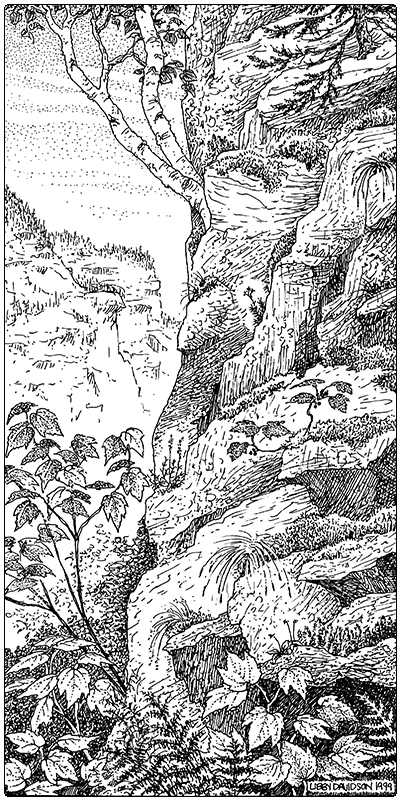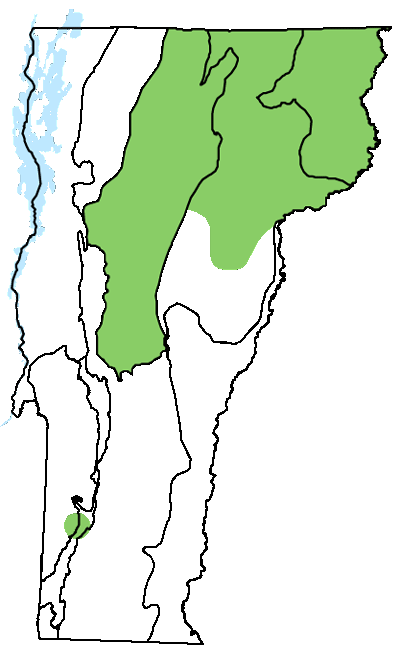Ecology and Physical Setting
With their rare and unusual plants, Boreal Calcareous Cliffs have attracted the attention of botanists for over a century. They are among Vermont’s most captivating natural communities.
Boreal Calcareous Cliffs occur on calcareous schist, limestone, and occasionally marble, at relatively high elevations (over 2,000 feet in most cases) throughout Vermont. The rock types vary in origin, structure and hardness, and the plant communities that occur on them are likewise variable. But they all share three features: calcium and other plant nutrients are present in the rock; the rock breaks down rapidly enough to release some of these nutrients; and moisture moves through fractures in the rock, carrying these nutrients to the cliff surface where plants are growing. The combination of calcareous rock, a ready supply of mineral-rich groundwater, cold temperatures, and vertical rock faces is very unusual in Vermont, making this community quite rare.
In some cases, the calcareous rock may only occur as small bands within otherwise acidic rock, but its influence is significant enough to shape the entire community. This occurs in schists of the Northern Green Mountains.
Moisture serves not only to move nutrients, but also to break down rock through winter freezing and thawing, thus moving rock and soil and creating unstable conditions. Landslides are a dramatic result of this instability. On the larger Boreal Calcareous Cliff complexes at Smugglers Notch and Lake Willoughby, talus gullies and landslides interrupt the cliff faces. The gullies funnel talus downslope, often carrying cliff plants to new habitat below. Another result of landslides is the creation of new habitat for the germination of the plants that are adapted to bare soils and rock.
Vegetation
Vermont’s 19th century botanical explorers were so intrigued by Boreal Calcareous Cliffs that they named one favorite site “The Garden of Eden.” The great diversity of rare and interesting plants, many of which grow in no other natural communities in the state, explains the fascination with these places. Many of these species, such as scirpus-like sedge, purple mountain saxifrage, and pale-painted cup, have northern affinities and evoke Newfoundland and the Gaspé Peninsula.
Vascular vegetation on Boreal Calcareous Cliffs is generally sparse, but lichens and bryophytes can be abundant.Moister areas may have more plant cover and higher plant richness. In especially seepy places, diversity may be quite high, and there may be concentrations of rare species.
Wildlife Habitat

These cold, northern cliffs provide nesting sites for peregrine falcons, common ravens, and turkey vultures. The rock ledges and crevices are secure from terrestrial predators. Both peregrines and ravens have elaborate aerial courtship displays, including diving, tumbling, and soaring together. Peregrine falcon pairs typically mate for life, returning to the same cliff spring after spring, even though they spend the winters separately in South America and the Caribbean.
Related Communities
- Boreal Acidic Cliffs lack a diversity of calcium-loving plants. At some sites, Boreal Acidic Cliffs may be found adjacent to Boreal Calcareous Cliffs, because of local variation in bedrock chemistry and groundwater seepage.
- Temperate Calcareous Cliffs occur at elevations below 2,000 feet and tend to be drier and more stable. They support species like maidenhair spleenwort, smooth cliffbrake, and walking fern. Northern white cedar can be present in both Temperate and Boreal Calcareous Cliffs.
Conservation Status and Management Considerations
Several examples of this rare community type are protected, but all can be damaged by rock and ice climbing. Climbers should use care to avoid damaging plants or causing erosion, by choosing a path using bare rock or thick ice flows. The thin layer of saturated organic soil (sometimes called “turf”) found on ledges and in crevices on Boreal Calcareous Cliffs is extremely fragile and can support many rare species. Many cliffs in Vermont are closed to recreational activities during peregrine falcon nesting season.
Distribution/Abundance
This is a rare community type in Vermont. The best examples are in the Northeastern Highlands and the Northern Green Mountains, but there are examples in the Northern Vermont Piedmont, and Taconic Mountains as well. Related communities can be found in the Gaspé Peninsula of Québec and throughout the boreal region of northeastern Canada.
Characteristic Plants
Trees
Red spruce – Picea rubens
Northern white cedar – Thuja occidentalis
Paper birch – Betula papyrifera
Yellow birch –Betula alleghaniensis
Shrubs
Shrubby cinquefoil – Dasiphora fruticosa
Green alder – Alnus viridis
Mountain maple – Acer spicatum
Striped maple – Acer pensylvanicum
Purple-flowering raspberry – Rubus odoratus
Swamp red currant – Ribes triste
American mountain ash – Sorbus americana
Herbs
Kalm’s lobelia – Lobelia kalmii
Early saxifrage – Micranthes virginiensis
Scirpus-like sedge – Carex scirpoidea
Brownish sedge – Carex brunnescens
Steller’s cliffbrake – Cryptogramma stelleri
Bulblet fern – Cystopteris bulbifera
Rand’s mountain goldenrod – Solidago randii
Harebell – Campanula rotundifolia
Large-leaved aster – Eurybia macrophylla
Appalachian firmoss – Huperzia appressa
Fragile fern – Cystopteris fragilis
Ebony sedge – Carex eburnea
Rare and Uncommon Plants

can photosynthesize during sunny periods even in the middle
of winter.
Roseroot – Rhodiola rosea
Purple mountain saxifrage – Saxifraga oppositifolia
White mountain saxifrage – Saxifraga paniculata
Yellow mountain saxifrage – Saxifraga aizoides
Boreal wormwood – Artemisia campestris ssp. canadensis
Fragrant fern – Dryopteris fragrans
Smooth woodsia – Woodsia glabella
Birds-eye primrose – Primula mistassinica
Scirpus-like sedge – Carex scirpoidea
Butterwort – Pinguicula vulgaris
Blake’s milk-vetch – Astragalus robbinsii var. minor
Hyssop-leaved fleabane – Erigeron hyssopifolius
Braya – Braya humilis
Few-flowered spikerush – Eleocharis quinqueflora
Capillary beak-rush – Rhynchospora capillacea
Alpine sweet-broom – Hedysarum alpinum
Green spleenwort – Asplenium viride
Bentgrass – Calamagrostis stricta ssp. inexpansa
Weft fern – Crepidomanes intricatum
Laurentian bladder fern – Cystopteris laurentiana
Rock whitlow-grass – Draba arabisans
Hoary whitlow-grass – Draba cana
Felwort – Gentianella amarella
Spike woodrush – Luzula spicata
Deer-hair sedge – Trichophorum cespitosum
Alpine woodsia – Woodsia alpina
Northern pale painted cup – Castilleja septentrionalis
New England arnica – Arnica lanceolata
Blackish sedge – Carex atratiformis
Marble sandwort – Minuartia rubella
Blue dew moss – Saelania glaucescens
Moss – Plagiobryum zieri
Luminous moss – Schistostega pennata
Associated Animals
Turkey vulture – Cathartes aura
Common raven – Corvus corax
Rare and Uncommon Animals
Peregrine falcon – Falco peregrinus
Places to Visit
Mount Pisgah, Westmore, Willoughby State Forest, Vermont Department of Forests, Parks, and Recreation (VDFPR)
Smugglers Notch, Stowe and Morrisville, Mount Mansfield State Forest, VDFPR
Mount Horrid, Rochester, Green Mountain National Forest
